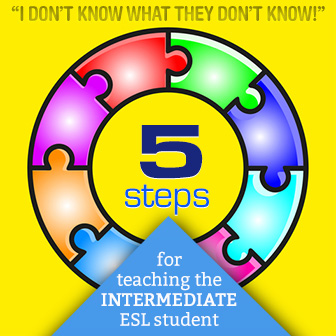Addressing Student Individual Needs: (But How do You Even Know What They Are?): Methods to Target Student Areas for Growth


The students understand everything you say, can follow directions, and can carry on a conversation. After a week or so, however, you realize it is NOT a breeze. In fact, it’s much more challenging than any class you’ve taught yet! A small contingent of students complains of being bored while other students say they can’t understand any of the material. You seem to spend more time on lesson planning than ever before, with only student boredom and confusion to show as a result. Even the student who seems to you the most fluent in English and acculturated to the U.S. confesses he spends hours on his homework and still doesn’t understand it. What’s going on?
Well, the first problem is to paraphrase a scholar on the topic of assessment, “there are many rooms in the house of ‘intermediate.’” Many different students with different levels of English skill can be legitimately called “intermediate”: for example, those with strong conversational and life skills in English but almost no academic or literacy skills as well as those with strong reading and writing skills who have trouble carrying on a conversation. This creates a problem for curriculum and instruction: what exactly do you focus on and teach in such a class? While you knew the appropriate material for a beginning student and an advanced student, the needs of the intermediate student are not so apparent. An activity, such as working on the distinction between simple present and present continuous tense, may interest some students but bore others. How may these problems be addressed?

Give a short diagnostic at the beginning of the term. For example, a small dictation followed by a reading with short answer questions is a versatile tool that can be used again and again. This doesn’t take a long time to administer, and it reveals some important information on each student’s reading, writing, and listening skills. In addition, the instructor can get some information about the class, collectively: if it is trending toward the low or high end of intermediate, for example, or if the class as a whole seems to have better reading and writing skills than listening. This information can inform future lesson planning.
Unlike beginning students, students at this level can be asked what they need to work on and what their goals are, both short and long term. If most of your students are job-oriented, for example, it might make more sense to work on conversational and pronunciation skills than on academic reading and writing. However, if more students have ambitions of obtaining a university degree, then additional emphasis can be placed on developing their academic vocabularies.
Textbooks often cannot meet the varied needs of an intermediate class because of the range of abilities and interests, and instructors may find themselves relying on supplementary materials such as newspaper and magazine articles and websites for teachers or chapters from select textbooks that allow duplication of class sets. If you notice a problem with present perfect tense, for example, you can just select a chapter from a grammar text to focus on that specific point rather than going through the whole text.
This variety of different materials increases the probability of reaching more students and holding student interest.
Just as the materials should be varied, so should the instruction. Instructors find themselves sometimes locked into a favorite mode of instruction, such as giving dictation, or playing vocabulary games, or student reading followed by class discussion. Using a variety of instruction rather than one type increases the probability of meeting all students’ needs.
And just as the materials and instruction should be varied in an intermediate class, so should the grouping strategies. Many ESL teachers have been trained in the value of group instruction, but not all students learn best this way. Some students learn best while working individually. The instruction should be varied from individual, to small group, to large group instruction throughout the course of a lesson.
As the semester progresses, you may note common problems in paragraphing, for example or in stress and intonation. Give lessons in these areas as you note the problems. Give frequent assessment, both formal assessments of quizzes and tests to the more informal homework checks as well as just walking around and noting student interactions in English during discussion. Use the information from these checks to adjust instruction.
Ask the students periodically how the class is going for them; they can give their feedback anonymously. I’ll do several of these checks throughout the semester, starting several weeks in, perhaps after the first test. I’ll ask students to write on a piece of paper the answer to the questions “How is the class going for you?” and “Are there any changes you’d like to see?” They then fold the paper and hand it in; no need to give a name. Most students just write things like “It’s great,” or “So far so good,” but sometimes they have valuable feedback like “I’d like more reading,” or “The teacher speaks too quickly”—sometimes painful but important information! Personally I like the validation of “Everything is perfect!” but this gives little information for improving the class. I’d rather know about concerns near the beginning of class when they can be addressed than in the course evaluation at the end.
Serving all of these different students with different skills and needs is not easy. In fact, the intermediate level may be the most difficult of the ESL levels to teach. However, by gathering information on the students and the class, varying materials and instruction, and gathering student feedback, the ESL teacher can meet student needs and set up a strong class.